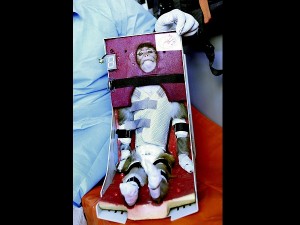Iranian space official: Photo shows wrong monkey

In this picture obtained from the Iranian Students News Agency, ISNA, scientists surround a monkey ahead of a space launch in an undisclosed location in Iran. A gray-tufted monkey strapped in a pod resembling an infant’s car seat rode an Iranian rocket into space and returned safely, officials said Monday, Jan. 28, 2013, in what was described as a step toward Tehran’s goal of a manned space flight. AP/ISNA, Mohammad Agah
TEHRAN, Iran—One of two official packages of photos of Iran’s famed simian space traveler depicted the wrong monkey, but a primate really did fly into space and return safely to Earth, a senior Iranian space official confirmed Saturday.
The two different monkeys shown in the photos released by Iran’s state media caused some international observers to wonder whether the monkey had died in space or that the launch didn’t go well.
One set of pictures showed a relatively dark-haired monkey. Another showed a different monkey — strapped in a pod — that had light gray hair and a distinctive red mole over its right eye.
Mohammad Ebrahimi told the The Associated Press that the monkey who traveled in space was named “Pishgam,” the Farsi word for pioneer. Initially, the Iranian media said “Pishgam” was the rocket that took him on a 20-minute journey into space on Monday.
Ebrahimi said one set of pictures showed an archive photo of one of the alternate monkeys. He said three to five monkeys are simultaneously tested for such a flight and two or three are chosen for the launch. Finally, the one that is best suited for the mission and isn’t stressed is chosen for the voyage.
State TV pictures seen by AP show the dark-haired monkey before and after the space flight, but a package of still pictures released by authorities showed the other monkey with the mole.
“I say this with certainty that the monkey is in good health and the space flight didn’t have any physical effect on Pishgam,” Ebrahimi said. “Some of the photos released by one of news agencies were not related to the time of flight. They were archive photos of the monkeys being prepared for the launch.”
Jonathan McDowell, a Harvard astronomer who tracks rocket launchings and space activity, also said this week’s monkey space flight was real, but he had a slightly different explanation for the photo mix-up. He claimed the light gray monkey with the mole died during a failed space mission in 2011.
“The monkey with the mole was the one launched in 2011 that died. The rocket failed. It did not get into space,” McDowell said. “They just mixed that footage with the footage of the 2013 successful launch.”
Iran has never confirmed that a monkey died in 2011, or that there was a failed mission that year.
Iran’s space officials said sending the monkey into space was a step toward Tehran’s goal of a manned space flight. However, the U.S. and its allies worry that the same technology used to launch rockets into space could also be used to develop long-range missiles.
With its ambitious aerospace program, Iran has said it wants to become a technological powerhouse for the Islamic world by 2026.
It’s not the first time Iran has announced it had rocketed a live creature out of the Earth’s atmosphere. The country sent a mouse, a turtle and some worms into space in 2010, officials said.
Pishgam was sent aboard an Explorer rocket and traveled to a height of 120 kilometers (72 miles), pushing into the threshold of space.
Ebrahimi said Iran plans to launch its first manned space mission within the next five to six years. He said it will be the first manned suborbital flight.
Hamid Fazeli, director of Iran’s space agency, said this week that Iran will launch a bigger rocket carrying a larger animal to obtain greater safety assurances before sending a man into space.
Iran says it wants to put its own satellites into orbit to monitor natural disasters in the earthquake-prone nation, improve telecommunications and expand military surveillance in the region.